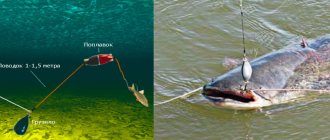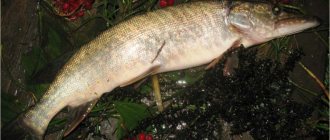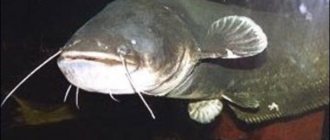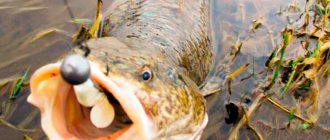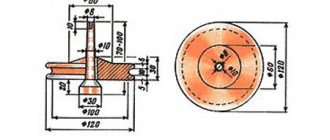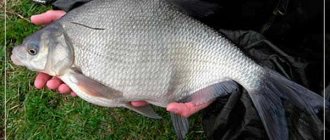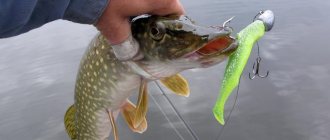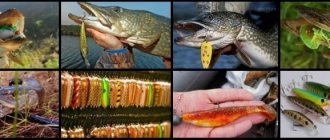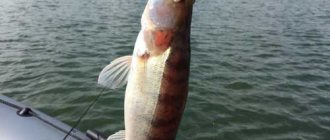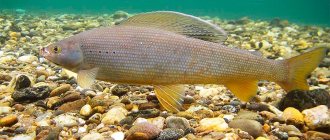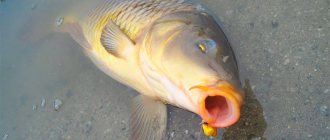Burbot is considered one of the most mysterious fish on our planet. The bulk of fish are caught in the warm season, while burbot at this time hides at the very bottom of the reservoir, but with the advent of autumn cold weather it comes out of its hiding places and begins its life activity. Its peak activity occurs at the very peak of winter cold, which in itself is unique.
Catching burbot in the fall with a catch
The activity of this fish increases as water temperatures drop, so fall fishing can guarantee catching burbot. Burbot can be caught using a spinning rod or using feeder gear, but the most effective is considered to be a bait. In addition, such gear is considered the simplest and most inexpensive. If you place several hooks along the shore, in places where burbot is active, you can count on productive fishing.
This article tells you how to prepare your tackle, what to use to catch this fish, and where and in what parts of the reservoir this fish prefers to be.
Fishing with a bait without a rod
Zakidushki are the ancestors of modern bottom gear; our grandfathers and great-grandfathers used to fish with them. But even now, many fishermen use similar gear and catch trophy fish in large quantities.
The zakidushka consists of:
- wooden reel with one extended leg;
- fishing lines 70–100 meters long, 0.35-0.5 mm in diameter;
- installation with weight and leashes, tied directly to the main fishing line.
In general, it is recommended to knit rigs for hooks on a separate piece of fishing line 50–100 cm long and 0.30 mm in diameter and tie them to the base while fishing.
In addition to the fact that this design is convenient from the point of view of transportation, if it gets caught on bottom debris, only the hook or the installation itself will come off, and the main fishing line will remain intact, since it is thicker.
In any case, the design of the zakidushka remains unchanged, and installation is done as follows:
- a sinker on a swivel is attached to the end of the fishing line;
- 5 cm above the sinker, 3–5 leashes 3–5 cm long are tied in increments of 8–10 cm;
- At the second end of the fishing line, a loop is knitted to connect to the base.
The design of the tackle is simple and knits very quickly, even on the shore of a reservoir. The weight of the sinker is selected depending on the presence and strength of the current, the size of the hooks depends on the size of the baits used and the expected fish in the catch.
The disadvantage of the classic bait is the absence of a feeder for bait, so you have to feed the fish with balls from a slingshot or manually. There are fishermen who put a spring feeder on a casting hook, but the classic version does not have one.
They cast the cast by hand, but before that you need to unwind the main line from the reel for the entire casting length and fold it in rings on the shore. Next, the angler picks up the end of the fishing line with a sinker and leaves a 30-50 cm overhang. Swinging the load like a pendulum, the tackle is thrown into the water, and the main fishing line is carefully unwound along its entire length.
Important! Before casting, the fishing line should only be folded into rings, then it will not get tangled or break when casting.
Bottom night fishing for casting is complicated by the fact that due to poor visibility, the tackle gets tangled more often when casting, and it is not always possible to throw it in the right place. Unwind as much fishing line as possible from the reel, otherwise when casting, not only the tackle, but also the cast itself will fly into the water.
After casting the rig, the line is reeled in so that there is tension, and the reel is stuck into the sand. The bite alarm is an ordinary bell with an elastic band on which a slot is made for attaching to a fishing line.
To ensure that the fishing line remains taut at all times and bites are clearly visible, a regular stand or branch in the shape of a stag is placed between the reel and the edge of the water, and the fishing line is placed on it.
The bell goes lower, closer to the water, and it is better to tie it additionally to the stand so that after a strong hook it does not fly into the water. When bitten, the bell makes a melodious ringing and you need to have time to hook.
If the alarm goes down, it means the fish has bitten the shore; if it goes up, it means it has gone deeper.
The lack of a fishing rod makes it difficult to catch fish , especially large ones. Firstly, the fishing line cuts your hands, and secondly, it is impossible to quickly release the required amount of fishing line in order to let the fish in and prevent it from breaking away. In spinning reels, the clutch is responsible for this; when fishing by hand, you have to “give” the line, unwinding it from the reel.
When fishing in a current, the bait is also cast diagonally to increase sensitivity and reduce water pressure. If there is no bite, the bait is re-thrown every 30–40 minutes, and the bait is changed to a fresh one.
Installation of the nook
Nowadays, many fishermen may not know anything about casting, since they use more modern gear, such as a spinning rod or a feeder. In fact, the zakidushka is the simplest tackle, which is intended for catching fish from the bottom.
Essentially, this is bottom tackle, which has some differences in its design compared to a feeder, for example. This tackle (tack) consists of the following elements:
- Fishing line.
- Leash.
- Sinker.
- Hook.
- Reel or rod with reel.
As a rule, this is a minimum set of elements, which can be supplemented with auxiliary elements, such as leashes, a bite alarm, and a rod with a reel is used instead of a reel.
Rod selection
. For this type of fishing, both a regular reel, which is very popular in our time, and any rod that can withstand the weight of this fish are suitable. This can be a regular spinning rod or a powerful carp fishing rod. The main thing is that fishing brings a lot of positive emotions.
Coil selection
. As a rule, the rod is equipped with an inertia-free reel of size 3500/4000.
Line selection
. Since burbot is still a large fish, the diameter of the fishing line is selected depending on the average size of this fish living in a particular body of water. A fishing line thickness of 0.3-0.4 mm may be sufficient, while the diameter of the leader is chosen to be 0.05 mm thinner compared to the main fishing line. The color of the fishing line has virtually no effect on fishing performance.
Selection of hooks
. Basically, anglers prefer hooks of numbers from No. 8 to No. 14, and both single and double hooks can be used. Some fishermen argue that it is better to use double hooks, since the burbot does not swallow them deeply, which does not lead to injury to the fish. Some anglers disagree with this and believe that single hooks release much easier.
Sinker selection
. The weight of the sinker depends on the strength of the water flow in the selected fishing area. In this regard, the weight of the sinker can be in the range of 20-100 grams. The shape of the sinker also matters. When it is streamlined, it creates less resistance to flow.
The nuances of catching bream in September on a donka
I would like to ask a question about September fishing for bream on a donk. Where to look for fish in the fall, and are the equipment, groundbait and bait different in any way? I read somewhere that activity decreases towards the end of summer.
Autumn fishing for bream and bream is just as interesting as summer fishing. Biting activity depends on many factors: weather, pressure, characteristics of the reservoir, etc. Unlike the warm water season, the fall bream bite may begin closer to 10 a.m., rather than at dawn. At the beginning of autumn, flocks of white bream do not leave their usual habitats, but with a significant drop in water temperature they slide into deep channel holes. The equipment is, first of all, distinguished by its delicacy. The thickness of the leash should not exceed 0.16 mm, while hooks are used from thin wire; they are most successful at cutting fish. In reservoirs with a current, the bream bite is a little more active, since the circulation of water saturates the space with oxygen, and the rivers become covered with ice more slowly.
The behavior of the fish forces you to adapt to it. Feeding is carried out pointwise, in places where bream are definitely present. It will not be possible to lure him with an aromatic mixture to another point, since in the fall he behaves warily and leaves the fishing zone at the slightest danger. Feed is used in small quantities so as not to frighten off the fish. When working with a feeder, it is necessary to replace large feeders with smaller models. Donk fishing also does not require a huge feeding spot on the bottom. The optimal bait is considered to be a worm and maggot. The plant option has its place, but in most cases it is less effective. It is better to leave the use of additional attractants for the next summer season. The basis of the bait is pea or millet groats. Chopped worms, food bloodworms or ground zebra mussels must be added to it. It is also necessary to darken the mixture with clay or sifted soil.
To learn more:
Catching Black Sea shrimp - the best ways
You should start fishing in the upper reaches of the holes where the fish are accustomed to go out to feed. If there are no bites, it is worth experimenting with the fishing location, throwing donks to different parts of the reservoir. In shallow water, autumn bream is extremely rare, so you need to look for deep-sea edges and depth changes. If the hole is located under this bank, it is advisable to use a fly rod. The bait should lie motionless on the bottom, since passive fish react weakly to fishing with the wire. Elements of equipment must be delicate. The sinker is used as a sliding one, and it will serve as the main load of the float.
Bait for throwing
To catch burbot, a wide variety of types of bait are used, with the most popular ones being available. The type of bait depends on whether the fish is predatory or peaceful. As for burbot, it belongs to the category of predatory fish, so it is preferable to use baits of animal origin.
Fishing with live bait
. As a rule, a small fish is used, such as a gudgeon or roach, attached to a hook in any way, as long as the fish remains active in the water column for a long time.
Live bait moves in the water quite naturally, so burbot attacks this bait at the first opportunity.
Fishing with pieces of fish
. A piece of meat is more attractive to burbot, as it has a richer fishy aroma, which attracts burbot located at a considerable distance. Unfortunately, a piece of fish meat, being in the water, quickly loses its functions as an attractive bait.
Fishing with a frog
. The type of bait depends on the characteristics of the reservoir, so some baits may work and some may not. The same applies to the frog, since some fishermen consider this type of bait effective and irreplaceable, while others consider it useless.
Fishing with worms
. Worms are considered the most catchy and versatile bait, regardless of the nature of the reservoir. Since the burbot's mouth is large and wide, several worms are attached to the hook at once, in the form of a large cluster.
Technique for catching burbot using a hook
Burbot emerges from its hiding places in search of food at night, about an hour after sunset. Naturally, you need to arrive at the fishing spot a couple of hours before, so that you have time to set up your supplies. After the sun sets, the burbot bite begins, which continues until about one in the morning. After this, you shouldn’t count on a bite, although many anglers leave their gear until the morning, but this is quite risky. In case of a bite, the burbot will try to immediately go into the nearest snag. As a rule, the fisherman is left without a catch and without gear.
The autumn burbot bite can be described as a cautious bite, so the tackle should be quite sensitive. Burbot bites look like a weak twitch, so anglers advise to loosen the line a little at this moment in order to remove excess tension, then the burbot will be somewhat bolder. After 10 seconds you can safely make a hook. It is very important that the fishing process be careful, without using excessive force, otherwise you can tear the burbot’s lip, which is quite soft and fragile.
Features of catching burbot on a donk in September, October and November
Burbot is a fish that prefers to live in cold water, so it is most active in autumn and winter. It is difficult to say which of the autumn months is the most productive, but this fish has its own habits.
- In September, when the water just begins to cool, the burbot wakes up and begins preparing for the pre-spawning feast. In this regard, you should not count on active burbot biting at the beginning of the month, although even in September there may be quite cold periods, with a significant decrease in temperature. These are the ones you should focus on.
- In October you can already count on productive fishing. This month he is quite active, going out at night in search of food.
- Fishing in November is the most promising, since burbot is the most active this month. This month he tries to gain as many nutritional components as possible, since spawning begins in December. We can safely say that November is the most suitable time for catching this amazing fish.
Experts' comments
Experts believe that burbot is still considered the most mysterious fish today, since its habits have not been fully studied. They practically do not know where burbot hides in the summer and what and how it feeds at this time. What is known is that with the onset of autumn it begins to be caught on fishermen’s gear. Therefore, fishermen focus specifically on the autumn period, when they go fishing in order to catch burbot.
Based on the many years of experience of some fishermen, we can say that:
- You should not try to catch burbot on a spinning rod purposefully, as your time will be wasted. In this case, more pike or pike perch are caught on the hook than burbot. Therefore, fishing for pike or pike perch can bring an unexpected bonus in the form of burbot.
- As a rule, burbot can be caught in the same places as other predatory fish. Therefore, you should expect that burbot can hide in snags, in sandy areas with complex bottom topography, as well as in riverbed holes, including stone deposits.
- When going fishing with the idea of catching burbot, you should give preference to baits such as live bait or a huge bunch of worms.
- The more hooks, the greater the chances of catching this fish. It is most preferable to tie on simple hooks and throw them, securing them on the shore with strong stakes. In this case, the gear can be left until the morning, after which it is checked, but there are many risks here.
- Burbot should not be placed on kukan, since it does not have a hard cartilaginous chin, compared to the same pike and pike perch. He will easily tear his mouth and leave the kukan.
It’s not so easy to catch burbot, so the most common ones are medium-sized ones, weighing up to 3 kilograms. Despite this, such individuals are encountered quite often and regularly.
It should also be remembered that burbot can feed on carrion and because of this, many do not catch it purposefully, since you can pull out of the water a rather unpleasant-smelling burbot, which hardly anyone would want to cook at home and then eat.
Features of fishing in September
In September, the fish stops standing in one place, it begins to walk around the reservoir, lingering more and more often in the depths and visiting shallow water less and less. However, the bite in September may be unstable. This is mainly due to weather conditions and atmospheric pressure, to changes in which the fish are very sensitive.
At the beginning of September, all the fish still live according to the usual summer schedule. The algae have not yet died off, and a lot of natural food can be found among them. Insects fly, fall into the water, or are washed into the reservoir by streams of rainwater.
The predator is also more active in the morning and evening. But as soon as temperature changes begin, the behavior of underwater inhabitants changes radically. It either stands close to the shore, then moves to the depths, then begins to actively peck, then becomes lethargic and motionless.
Be that as it may, with the right choice of fishing location and selection of bait, the angler’s success is still guaranteed.
Bait and bait in autumn
While the weather is warm and the water has not yet cooled down, peaceful fish continue to peck perfectly on vegetable baits - dough, bread, corn, pearl barley, semolina, etc. But gradually her gastronomic tastes will change towards baits of animal origin - worms, maggots, bloodworms and others, until they completely replace them. The best fall bait will be animal food.
When catching peaceful fish, bait is required. It must meet the fishing requirements of a particular species. For example, to catch large fish, it is better to take bait consisting of large fractions. Small fish should be lured with almost bait dust, which creates a cloud of turbidity in the water.
In addition, live ingredients must be added to the autumn bait - chopped or ground worms, maggots, and bloodworms.
It is better not to experiment with flavorings. The fewer of them there are in the bait mixture, the better. With the onset of autumn, fish begin to react painfully to too strong odors, and strong-smelling bait can simply scare it away.
Making a do-it-yourself snack
You can see how to make your own gear for catching burbot in the following video. You can make sure that this is really simple tackle that can be made in just a few minutes; you just need to purchase the necessary components in the form of fishing line, sinker and hooks. If someone prefers a reel, then the tackle is also budget-friendly, since you don’t have to spend money on a rod and reel.
Catching burbot in the fall is not an easy task, since the temperature of the water and the environment creates a certain level of discomfort, but the colder it is outside for a person, the more favorable it is for burbot.
Bait selection
Bream fishing in September provides the opportunity to use a variety of baits. Bloodworms are very popular among experienced fishermen, and corn or worms are slightly less popular.
Pay attention to the information on how to cook cold smoked bream.
Also in the arsenal of “breamers” you can find:
- maggots;
- pearl barley;
- dough;
- peas;
- steamed wheat;
- pasta;
- pellets
Foam balls can be an unexpected, but quite effective way of bait - their appearance attracts not only bream, but also other carp fish.
